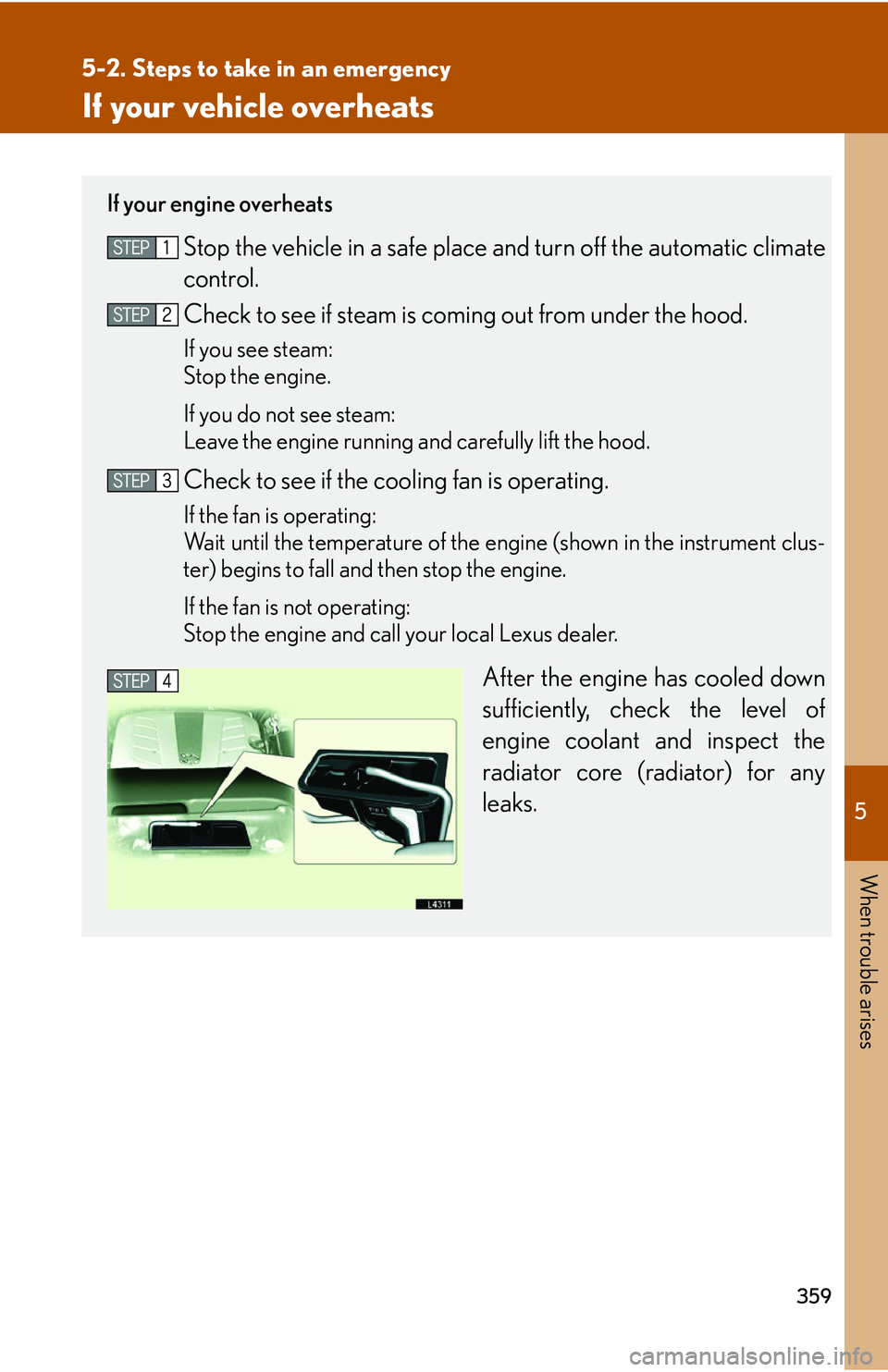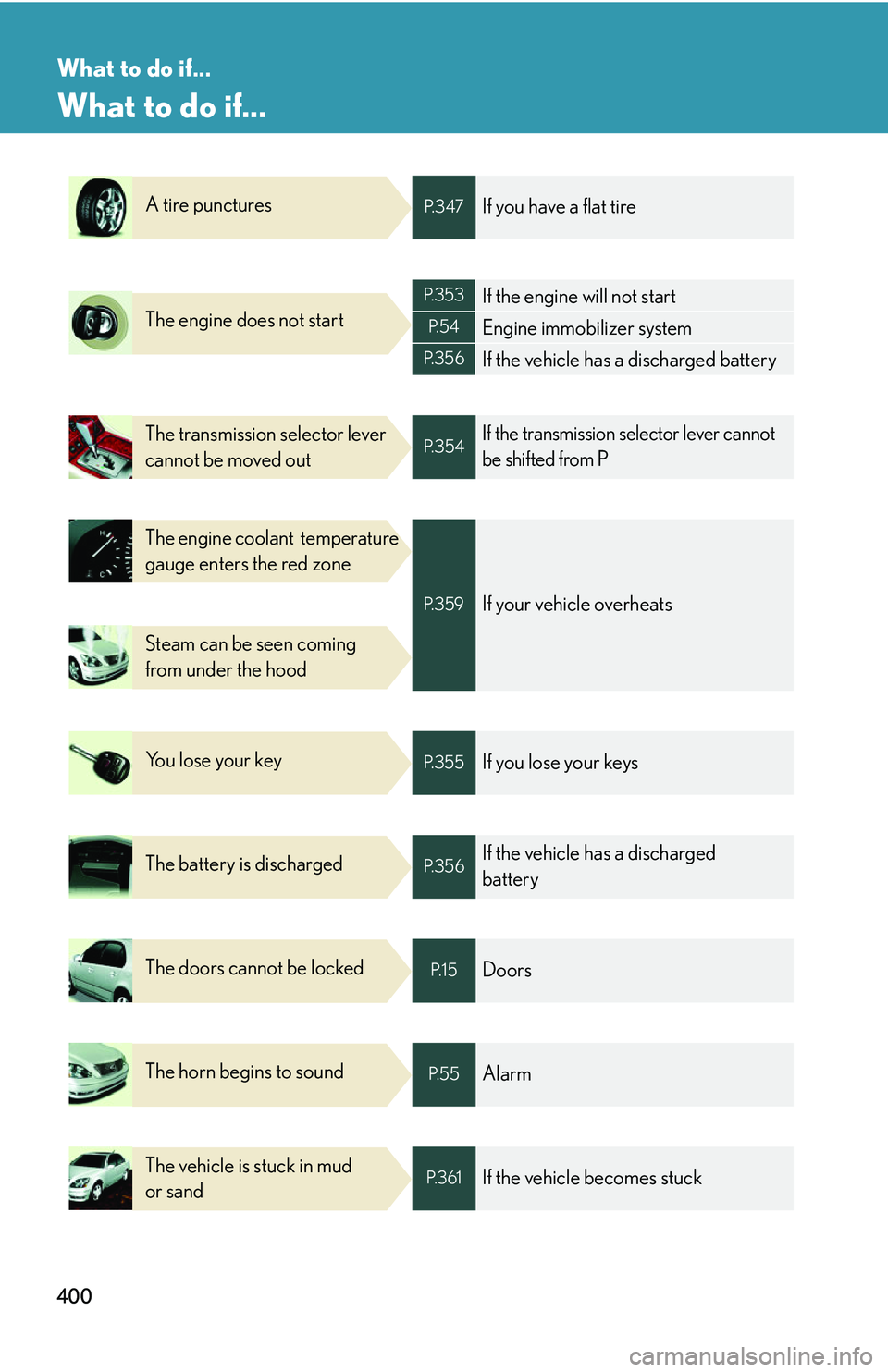2006 LEXUS LS430 coolant temperature
[x] Cancel search: coolant temperaturePage 119 of 419

103
2
When driving
2-2. Instrument cluster
Gauges and meters
When the ignition switch is turned to ON;
Engine coolant temperature gaugeDisplays the engine coolant temperature.
Tachometer
Displays the number of engine speed in revolutions per minute.
Speedometer Displays the vehicle speed.
Fuel gauge Displays the quantity of fuel remaining in the tank.
Trip meter reset button
Resets the distance traveled to 0 mile (0 km).
Trip meter button Changes between trip meter A and B indication.
Trip meter A and trip meter B Trip meters display the distance the v
ehicle has been driven since the
meter was reset.
1
2
3
4
5
6
7
Page 165 of 419

149
2-5. Driving information
2
When driving
Winter driving tips
Carry out the necessary preparations and inspections before driving the
vehicle in winter. Always drive the vehicle in a manner appropriate for the
prevailing weather and roadway conditions.
■ Pre-winter preparations
●Use fluids appropriate to the p revailing outside temperatures.
• Engine oil
• Engine coolant
• Washer fluid
●Inspect the level and specific gravity of battery electrolyte.
●Have the vehicle fitted with four sno w tires or purchase a set of tire
chains for the rear tires.
Ensure that all tires are the same si
ze and brand, and that chains
match the size of the tires.
■ Befor
e driving the vehicle
Perform the following steps acco r
ding to the driving conditions.
●Do not forcibly try to open a window or move a wiper that has fro-
zen. Pour some warm water over the frozen area to melt the ice.
Wipe away the water immediately to pr
event it from freezing.
●To ensure proper operation of the climate control system fan,
remove any snow that has accumulated on the air inlet vents in front
of the windshield.
●Remove any ice that has accumulated on the vehicle chassis.
●Periodically check for and remove any excess ice or snow that may
accumulate in the wheel well or brakes.
Page 173 of 419

157
2-5. Driving information
2
When driving
• As stopping distance is increased when towing a trailer, vehicle-to-
vehicle distance should be increas ed. For each 10 mph (16 km/h) of
speed, allow at least one vehicle and trailer length.
• Avoid sudden braking as you may sk id, r
esulting in jackknifing and loss
of control. This is especially true on wet or slippery surfaces.
• Avoid jerky starts or sudden acceleration.
• Avoid jerky steering and sharp turn s, and slo
w down before making a
turn.
• Note that when making a turn, the tr ailer wheels will be closer than the
v
ehicle wheels to the inside of th e turn. Compensate by making a
larger than normal turning radius.
• Crosswinds and rough roads will ad v
ersely affect handling of your
vehicle and trailer, causing sway. Peri odically check the rear to prepare
for being passed by large trucks or buses, which may cause your vehi-
cle and trailer to sway. If s
waying occurs, firmly grip the steering wheel,
reduce speed immediately but gradually, and steer straight ahead.
Never increase speed. If you make no extreme correction with the
steering or brakes, your vehi cle and trailer will stabilize.
• Take care when passing other vehicl es. P
assing requires considerable
distance. After passing a vehicle, do not forget the length of your
trailer, and be sure you have plenty of room before changing lanes.
• In order to maintain efficient engine br
aking and electrical charging
performance, do not use overdrive. Transmission shift range position
must be in “4”, in the “S” mode.
• Due to the added load of the traile r
, your vehicle’s engine may overheat
on hot days (at temperatures over 85°F [30°C]) when driving up a
long or steep grade. If the engine coolant temperature gauge indicates
overheating, immediately turn off the air conditioning (if in use), pull
your vehicle off the road and stop in a safe spot. See “If your vehicle
overheats” ( P.359 ).
Page 274 of 419

258
4-3. Do-it-yourself maintenance
CAUTION
The engine compartment contains many mechanisms and fluids that many move
suddenly, become hot, or become electrically energized. To avoid death or serious
injury:
■When working in the engine compartment:
●Keep hands, clothing, and tools away from the moving fan and engine drive belt.
●Be careful not to touch the engine, radiator, exhaust manifold and power steering
fluid reservoir, etc. right after driving as they may be hot. Oil and other fluids may
also be hot.
●Do not leave anything that may burn easily , such as paper or rags, in the engine
compartment.
●Do not smoke, cause sparks or expose an open flame to fuel or the battery.
Fuel and battery fumes are flammable.
●Be extremely cautious when working on the battery.
It contains poisonous and corrosive sulfuric acid.
■When the engine is running
Perform maintenance checks with adequate ventilation
■When working near the electric cooling fan or radiator grill:
Be sure the ignition is off. With the igni tion on, th
e electric cooling fan may automat-
ically start to run if the air conditioning is on and/
or if the coolant temperature is
high. ( P.262 )
■When working on or under the vehicle:
●Do not get under the vehicle with just the jack supporting it.
Always use automotive jack stands or other solid supports.
●Use eye protection to prevent flying or falling material, fluid spray, etc. from get -
ting in your eyes.
Page 340 of 419

324
5-1. Essential information
If you think something is wrong
If you notice any of the following symptoms, your vehicle probably needs
adjustment or repair. Contact your Lexus dealer as soon as possible.
■Visible symptoms
Look for any of the following symptoms.
• Fluid leaks under the vehicle
Water dripping from the air conditioning after use is normal
• Flat-looking tires or uneven tire wear
• Engine coolant temperature gauge needle continually points higher
than normal
■ A
udible symptoms
Listen for any of the following symptoms.
• Change in exhaust sound
• Excessive tire squeal when cornering
• Strange noises related to suspension system
• Pinging or other noises related to engine
■ P
roblems with operation
Check for any of the following symptoms.
• Engine missing, stumbling or running rough
• Appreciable loss of power
• Vehicle pulls to heavily one side when braking
• Vehicle pulls to heavily one sid e when driving on a le
vel road
• Loss of brake effectiveness, sp ongy feeling, pedal almost touches
floor
Page 375 of 419

5
When trouble arises
359
5-2. Steps to take in an emergency
If your vehicle overheats
If your engine overheats
Stop the vehicle in a safe place and turn off the automatic climate
control.
Check to see if steam is coming out from under the hood.
If you see steam:
Stop the engine.
If you do not see steam:
Leave the engine running and carefully lift the hood.
Check to see if the cooling fan is operating.
If the fan is operating:
Wait until the temperature of the engine (shown in the instrument clus -
ter) begins to fall and then stop the engine.
If the fan is not operating:
Stop the engine and call your local Lexus dealer.
After the engine has cooled down
sufficiently, check the level of
engine coolant and inspect the
radiator core (radiator) for any
leaks.
Page 410 of 419

394
Alphabetical index
Driving position memory ......................25
Dynamic radar/laser
cruise control ....................................... 129
ECT Pattern select switch ......................... 99
Electronically modulated
air suspension ...................................... 138
Engine Compartment ..................................... 262
Hood........................................................ 260
How to start the engine..................... 94
If your vehicle will not start............ 353
Ignition switch......................................... 94
Malfunction indicator lamp........... 330
Engine coolant Capacity ................................................. 367
Checking ............................................... 268
Preparing and checking
before winter ......................................149
Engine coolant temperature
gauge....................................................... 103
Engine immobilizer system.................. 54
Engine oil Capacity ................................................. 366
Checking ............................................... 263
Preparing and checking
before winter ......................................149
Event data recorder ............................ 326
First-aid kit net........................................ 227
Fog lights Switch .......................................................... 113
Wattage.................................................. 372
Floor lights ................................................ 198Floor mats ................................................
224
Fluid Brake ........................................................ 270
Power steering .................................... 272
Washer.................................................... 277
Front passenger's seat
belt
reminder light ..................................... 332
Front seats Adjustment ............................................... 22
Fuel Capacity ................................................ 366
Fuel gauge .............................................. 103
Information ............................................ 373
Low fuel level warning light ........... 331
Refueling ..................................................... 51
Fuel filler door ............................................. 51
Fuel pump shut off system................. 325
Fuses Blade ...................................................... 298
Cartridge............................................... 309
Gas station information ..................... 402
Garage door opener .......................... 232
Gauge and meter.................................. 103
Glove box ................................................ 202
Glove compartment light Wattage .................................................. 372
Graphic information ............................ 109
Head restraints Adjusting..................................................... 31
Headlight aim ............................................ 311
Headlight cleaner.................................... 117
Headlights Operation ................................................. 110
E
F
G
H
Page 416 of 419

400
What to do if...
What to do if...
A tire puncturesP. 3 4 7If you have a flat tire
The engine does not start
P. 3 5 3If the engine will not start
P. 5 4Engine immobilizer system
P. 3 5 6If the vehicle has a discharged battery
The transmission selector lever
cannot be moved outP. 3 5 4If the transmission selector lever cannot
be shifted from P
The engine coolant temperature
gauge enters the red zone
Steam can be seen coming
from under the hood
P. 3 5 9If your vehicle overheats
You lose your keyP. 3 5 5If you lose your keys
The battery is dischargedP. 3 5 6If the vehicle has a discharged
battery
The doors cannot be lockedP. 1 5Doors
The horn begins to soundP. 5 5Alarm
The vehicle is stuck in mud
or sandP. 3 6 1If the vehicle becomes stuck